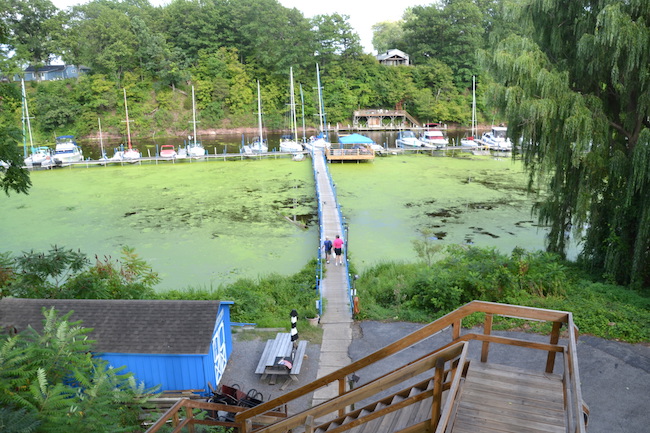Schumer highlights $1 billion for Great Lakes as part of infrastructure package
‘The Great Lakes are a massive economic engine, not only for the tourism and recreation industries, but also for the shipping, logistics, agriculture, mining, energy, and finance industries.’ – U.S. Sen. Charles Schumer

Photos by Tom Rivers: These sailboats race last Thursday in Lake Ontario near Point Breeze as part of the racing series organized by the Oak Orchard Yacht Club.
Press Release, U.S. Senate Majority Leader Charles Schumer
Standing on the banks of the Niagara River at Niawanda Park in Tonawanda on Monday, U.S. Senate Majority Leader Charles E. Schumer revealed an historic $1 billion federal investment – the largest ever single investment – in the Great Lakes Restoration Initiative (GLRI).
Specifically, this funding was secured to protect, improve, and preserve the Great Lakes and their related waterways, which Schumer was able to secure in the bipartisan federal infrastructure bill he just led to passage. Schumer detailed the unprecedented amount of funds, explained why he pushed to include them, and detailed how the Great Lakes Restoration Initiative (GLRI) has been helping Western New York since he first pushed for the funding in 2010. Schumer explained that these dollars will continue to improve water quality by reducing pollutants, restoring and protecting wildlife habitats, mitigating climate change impacts, and helping preserve waterways critical to New York State’s environment and economy.
“Today, I am unveiling the ‘catch of the day’ – $1 billion in funds we included in the bipartisan infrastructure package that will do a lot of good for Western and Central New York, and some critical things to protect one of the true gems of New York State – the Great Lakes,” said Senator Schumer. “This funding guarantees a ramp-up in our conservation efforts for the Great Lakes and their waterways, while allowing us to continue to fight for more as part of regular appropriations – so this is really unprecedented support for one of our most critical resources, both natural and economic. The Great Lakes are a massive economic engine, not only for the tourism and recreation industries, but also for the shipping, logistics, agriculture, mining, energy, and finance industries. Because of their huge impact on so many facets of life, investing in the Great Lakes means investing in the future economic health of Western New York.”
In total, the Great Lakes account for 84% of North America’s surface fresh water and contain about 21% of the world’s supply. More than 30 million people in the U.S. and Canada live in the Great Lakes Basin – roughly 10% of the U.S. population and more than 30% of the Canadian population. The Great Lakes themselves span more than 750 miles from west to east. Millions of people flock yearly to the Great Lakes for recreation, and the Lakes provide critical fresh water access. Additionally, the Lakes play host to diverse animal and plant life. The ability of the Great Lakes to support these uses is dependent on the quality of its waters, habitats, and living resources.

This photo shows the walkway leading to the docks and sailboats at the Oak Orchard Yacht Club along the Oak Orchard River, which is a Lake Ontario tributary.
Schumer also pointed out the massive economic impact of the Great Lakes region and its importance to Western New York. The Great Lakes region includes eight states – Minnesota, Wisconsin, Illinois, Indiana, Michigan, New York, Ohio, and Pennsylvania – and two Canadian provinces.
The Lakes are home to more than 175 species of fish, which contribute to our state’s vibrant commercial and recreational fishing industries. According to the Office of Coastal Management at the National Oceanic and Atmospheric Administration (NOAA), for every dollar invested in Great Lakes protection, the return on investment is $3.35, or 335%. Furthermore, for every $1 million invested in Great Lakes restoration and protection, 16 jobs are created. The Great Lakes Region is directly responsible for $3.1 trillion in Gross Domestic Product (GDP) for the United States and more than $6 trillion overall. It is estimated that 25.8 million jobs worth more than $1.3 trillion in wages spanning countless industries, including 7% of all American farm production, are directly supported by the region.
“We all know that our changing climate poses a threat to our Great Lakes and all the livelihoods that depend on it, so this $1 billion surge will help to accelerate efforts to protect and preserve one of our greatest natural resources,” Schumer added. “Even more, the economic impact of these Lakes is into the trillions. We cannot lose it. We must invest in sustainment, and we have to keep doing it to protect the economic future of Upstate New York and the environment.”
Schumer fought off budget cuts to the GLRI in 2019 and worked to secure a multimillion dollar increase in authorization levels for the program in 2018. Initiated in 2010, the GLRI has received roughly $3.48 billion since its inception, with the funds distributed across 16 different federal agencies including the Environmental Protection Agency (EPA) and the United States Army Corps of Engineers (USACE).
Over the last decade, the GLRI has controlled invasive species on at least 115,000 acres and kept more than 402,000 pounds of phosphorus out of the lakes, a $300,000 investment from GLRI which ended in 2020. GLRI has also played a critical role in fish and wildlife protection, specifically in Western New York. Efforts to improve the population of Lake Sturgeon are currently underway after a $90,000 investment to study their travel patterns, and the trout population is climbing once again thanks to the investment in bloater chub revival, a critical food source for the popular sport fish. Schumer noted that the $1 billion in funding, the largest the program has ever received in a single authorization, will help the agencies and their auxiliary partners prepare for the future.
Schumer was joined in Tonawanda by Erie County Executive Mark Poloncarz, Executive Director of Buffalo Niagara Riverkeeper Jill Jedlicka, Associate Director of the Citizen’s Campaign for the Environment Brian Smith, and other local stakeholders.
“New York is a Great Lakes state, and this $1 billion appropriation reinforces what we have known for a long time- that these freshwater lakes are the nation’s most important living infrastructure system,” said Jill Jedlicka, Executive Director of Buffalo Niagara Riverkeeper. “The health and restoration of the drinking water for 40 million people also supports tens of billions of dollars in economic activity and recreational resources. The Great Lakes Restoration Initiative has been one of the most impactful programs in our nation’s history by helping communities like Buffalo reclaim and restore their waterfronts, protect critical ecosystems, and put us back on a path to a clean water future. We applaud Senate Majority Leader Schumer for guiding this bipartisan infrastructure bill that will ultimately benefit all Americans and our Great Lakes.
The GLRI has also benefited additional sites in New York State. In September 2017, $900,000 worth of GLRI funds were awarded to the Great Lakes Institute at Hobart and William Smith College to fight invasive threats, including an infestation of hydrilla in Cayuga Lake. In 2015, Schumer helped secure $9.5 million in GLRI funding to restore Braddock Bay in the Town of Greece after decades of decline to ecological and recreational activities on the bay. The U.S. Army Corps of Engineers (USACE) used the funding to restore wetlands, habitat and to reconstruct a barrier beach that has been washed away, leaving the bay exposed to Lake Ontario’s damaging waters that destroyed habitat and the bay’s navigation channel needed for boating.





































































